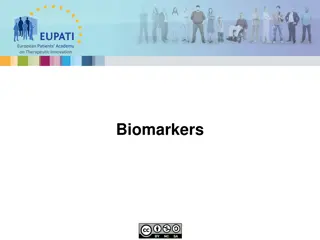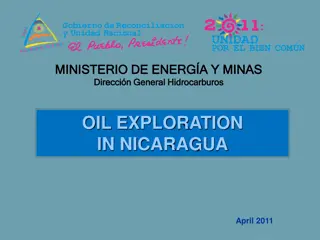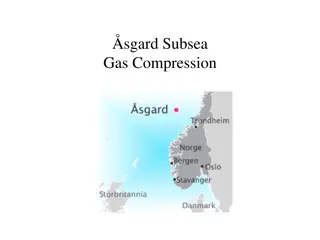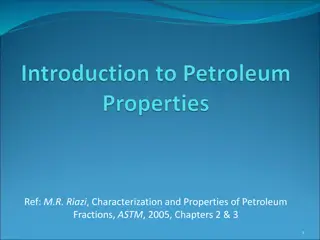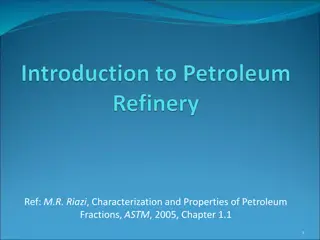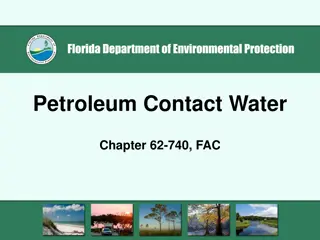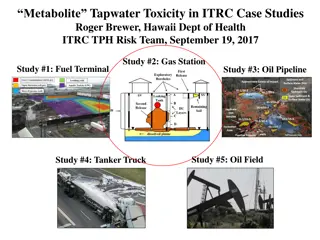Understanding Biomarkers and Maturity Parameters in Petroleum Exploration
Biomarkers and maturity parameters play crucial roles in characterizing source materials and assessing the thermal maturity of organic matter in petroleum exploration. Specific biomarkers and non-biomarker maturity parameters are utilized to determine the relative maturity of source rocks and oils. Parameters such as tricyclic terpanes, hopanes, and steranes are commonly used indicators of thermal maturity. By analyzing these markers, geologists can evaluate the level of maturity and potential oil generation in geological formations.
Download Presentation

Please find below an Image/Link to download the presentation.
The content on the website is provided AS IS for your information and personal use only. It may not be sold, licensed, or shared on other websites without obtaining consent from the author. Download presentation by click this link. If you encounter any issues during the download, it is possible that the publisher has removed the file from their server.
E N D
Presentation Transcript
MATURITY MATURITY Thermal maturity heat-driven reaction converts sedimentary organic matter into petroleum. In the same way, certain biomarkers have been used to characterize source materials and depositional environments. Selected biomarkers have been used to evaluate the relative maturity of suspected source rocks and the oils that may have generated (Philip, 2007). The commonly used parameters used as biomarkers are summarized below:
%Tricyclic terpanes/ (Tricyclics + 17Hopanes) % /( + -Hopanes (C30)) %Ts/(Ts+Tm) 18 /( + ).oleananes %20S/(20S+20R)-steranes (C29) %22S/(22S+22R)-Hopanes (C32) % /( + )-steranes (C29) %Diasteranes/(Diasteranes+regular steranes) %TA(I)/TA(I+II) 10. Moretanes/Hopanes 11. Ts/Hopanes 1. 2. 3. 4. 5. 6. 7. 8. 9.
12. C29 Ts/(C29 hopane + C29Ts) 13. (BNH/TNH)/hopanes 14. C26 Triaromatic 20S/(20S + 20R) 15. Other parameters are non-biomarkers. Maturity parameters of oil sample can be used to assess the relative level of thermal maturity (Peter et al., 2005). The more commonly non-biomarker maturity parameters are: 1. Isoprenoid/ n-alkane ratio 2. Carbon preference index (CPI) 3. Odd-to-even predominance (OEP) 4. Methyl phenanthrene index While not all of the maturity parameters will be discussed in details, it is useful to make short comment concerning most commonly used ones
17 Hopanes (C Hopanes (C19 of tricyclics Moldowan, , 1978 1 1. . Tricyclic Tricyclic / / 17 The The increaseing increaseing of (Seifert and (Seifert and Moldowan samples of crude oil is high indicating that oils are mature. samples of crude oil is high indicating that oils are mature. 2 2. . 22 22S/( S/(22 22S+ S+22 22R) R) Homohopane Homohopane isomerization isomerization typically using the 22 22S/( S/(22 22S+ S+22 22R) ratio rises from R) ratio rises from 0 0 to Moldowan Moldowan, , 1980 1980). During maturation the range of ratio ). During maturation the range of ratio ( (0.5 entered entered oil generation oil generation, while ratios in the range ( , while ratios in the range (0.57 phase of phase of oils generation oils generation has been has been reached or surpassed values of values of 22 22S/( S/(22 22S+ S+22 22R) for C R) for C31 and oil extracts indicate that oil of the study area is above early oil generation. and oil extracts indicate that oil of the study area is above early oil generation. 3 3. Ts/( . Ts/(Ts+Tm Ts+Tm) ) Thermal parameter based on relative stability of Thermal parameter based on relative stability of C C27 range immature to mature to range immature to mature to postmature postmature, but with strong dependence on source, also expressed as Ts/Tm (Peters et al., also expressed as Ts/Tm (Peters et al., 2005 degrades less during degrades less during diagenesis diagenesis and and catagenesis catagenesis. Thus, the ratio is an indicator of the maturity of the rock ( the maturity of the rock (Isaken Isaken, , 2004 2004). ). As seen from Table ( As seen from Table (4 4- -2 2) and Fig. ( ) and Fig. (4 4- -10 10 a, b) value of Ts/Tm of all samples of crude a, b) value of Ts/Tm of all samples of crude oils and oil extracts are moderate to high maturity. oils and oil extracts are moderate to high maturity. 25T)/(C T)/(C29 17 H H- -ratio 1978). From Table ( ). From Table (4 4- -2 2 a) it is obvious that this ratio for all a) it is obvious that this ratio for all 19- -C C25 29- -C C33 ratio leads to leads to increase oil thermal maturity increase oil thermal maturity 33H) H) tricyclics/ /17 typically using the C C31 to 0.6 0.6 ( (0.57 31 or C or C32 0.62 = equilibrium) (Seifert and = equilibrium) (Seifert and 0.5 0.54 0.54) has barely 0.57- -0.62 0.62) indicate that the main ) indicate that the main reached or surpassed (Peters et al., (Peters et al., 2005 31 and C and C32 32 in Table ( in Table (4 4- -2 2) for all samples of crude oil ) for all samples of crude oil 32 homologs homologs the the 0.57 0.62 ) has barely 2005). The ). The 27 hopanes hopanes applicable over the applicable over the , but with strong dependence on source, 2005). ). Ts Ts is is more stable than Tm more stable than Tm and . Thus, the ratio is an indicator of and
18 /( /( + + ) )- - oleananes 4 4. . 18 There is no oleananes in all samples of crude oils and rock extracts. 5 5. . 20 20S/( S/(20 20S+ S+20 20R) R) Isomerization Isomerization Steranes isomerization stereochemical conversions between biological and geological configuration at several a symmetric centers, which are used as an indicatorof thermal maturity includes 20S/(20S+20R) and /( + ) parameters (Peters et al., 2005). Isomerization at C-20 in the C29 5 , 14 , 17 (H)-steranes causes 20S/(20S+20R) to rise from to approximately 0.5 (0.52-0.55 = equilibrium) with increasing thermal maturity (Seifert and Moldowan, 1986). The ratio of steranes isomerization ranges between (0.47 0.73) that at or above peak oil generation in all sample of crude oils and medium to high maturity oils. 6 6. Ts/ . Ts/Hopane Hopane Volkman et al. (1983) proposed Ts/(C30 17 -H) as a maturity parameter for every mature oils and condensates. All samples of crude oils have Ts/H values ranges from (0.08-0.15) indicating early to peak oil generation except one 0.24 (Zubair Formation in NR-1) at above peak oil generation (Table 4-2). The rock extracts of the study area have value of Ts/H between peak oil generation to above peak oil. oleananes and and oleanane oleanane index (immature to early mature range) index (immature to early mature range)
7 7. . Moretanes Moretanes/ /hopanes High specificity for immature to early oil generation using C29 or C30 homologs (Peters et al., 2005). The 17 , 21 (H)-moretanes are thermally less stable than the 17 , 21 (H)-hopanes and be abundance of the C29 and C30 moretanes decrease relative to the corresponding hopanes with thermal maturity, the ratio decreases with thermal maturity (Peters et al., 2005). The value of this ratio, Table (4-2) for crude oils and rock extracts is less than 0.1 revealing that oil of the study area is mature, Fig. (4-10 a, b). 8 8. C . C29 29 Ts/(C Ts/(C29 29 hopanes hopanes) + C ) + C29 29 Ts) Ts) 18 -30 Norneohopanes (C29 Ts) abundance relative to the 17 -hopane is related to thermal maturity (Hughes et al., 1985). The thermal maturity effect on the C29 Ts/(C29 17 -hopane + C29 Ts) ratio should be comparable with but slightly less than that on Ts/(Ts+Tm) (Peters et al., 2005). Both parameters increase with thermal maturity as indicated by other marker parameters (Fowler and Brooks, 1990). In Table (4-2) the values of these parameters show that all sample have values indicating moderate maturity except the Zubair Formation in Nahr Umr-7 field which has high maturity. hopanes
9 9.(BNH+TNH)/ .(BNH+TNH)/hopanes The ratio is defined as (28, 30-bisnorhopanes + 25, 28, 30-trisnorhopanes) /(C29+C30 17 -hopanes) (Moldowan et al., 1984). The ratio decreases with thermal maturity, Table (4-2). All samples of crude oils and rock extracts have few values of this ratio indicating that all samples are mature. 10 10. . 20 20S/( S/(20 20S+ S+20 20R) R) Steranes Steranes C29 [20S/(20S+20R)-C29 cholestane was found to be ranges between (0.47- 0.73) in crude oils and (0.13-0.87) for rock extracts of study area which may revealing that oils at or above peak oil generation of thermal maturity, Table (4-2). 11 11. . Diasteranes Diasteranes/ /Steranes Steranes Thermal maturity lithology, and the redox potential of the source-rock deposition environment affect diasteranes/steranes (Peters et al., 2005). As a result, this ratio is useful for maturity determination only when the oil or bitumens being compared are from the same source-rock organic facies (Peters et al., 2005). Alternatively, heating in the post mature range induced destruction of biomarkers, and increased diasteranes/steranes might indicate better survival diasteranes under high temperature conditions (Peters et al., 2005). The ratio of diasteranes/steranes shown in Table (1) suggests that maturity at peak oil window (%Ro) for all samples of crude oil and rock extract. hopanes (also express as C (also express as C28 28/C /C30 30 hopanes hopanes) )
12 12.TA(I)/TA(I+II) .TA(I)/TA(I+II) It is commonly used for maturity. This ratio increases with thermal maturity. The 13 13. C . C26 26 triaromatic triaromatic 20 20S/( S/(20 20S+ S+20 20R) R) Highly specific for mature to highly mature ring C26 triaromatic 20S/(20S+20R) is more sensitive at higher levels of maturity than either C29 sterane ratio (Peters et al., 2005). The 20S/(20S+20R) ratio for the C27 and C28 triaromatic steroids shows trend similar to those for C26 triaromatic steroids with maturity. Although they are more erratic (Peters Moldowan, 1993). 14 14. . Isoprnoid Isoprnoid/ n / n- -alkane alkane ratios ratios They are specific for maturity, but also affected by other processes such as source and biodegradation (Peters et al., 2005). Pristane/n-C17 and phytane/n-C18 decrease with thermal maturity as more n-alkanes are generated from kerogen by cracking (Tissot at al., 1971) the ratios of Pr/n-17 and Ph/n C18 shown in Table (4- 2) indicate that all samples of crude oil are mature. 15 15. Carbon preference index and odd to even predominance (CPI and OEP) . Carbon preference index and odd to even predominance (CPI and OEP) CPI and OEP value significantly [(odd preference) {even preference)] one indicates low maturity oils from carbonate or hypersaline environments (Peters et al., 2005). CPI and OEP values of the study area indicate medium maturity for all samples of crude oil and rock extract, Table (4-2).
16 16.Aromatic maturity indicators .Aromatic maturity indicators Many maturity parameters are available based on the distribution of certain methylated aromatic hydrocarbons (Philip, 2007). There are many parameters for aromatic ratios: a)Methyl phenathrene index (MPI) One commonly used set of ratios is based on methylphenanthrene indices which has been shown in some cases to be similar or superior to vitrinite reflectance values (Radke et al., 1982). This ratio is written as (Cannan et al., 1988):
( 2 ( 5 . 1 ) + 3 ) MP MP (4-7) = MPI ( ) 1 + + 1 . 3 P MP MP ) MP . ( 2 ( 3 ) MP + = (4-8) MPI ( ) 2 + 1 9 P ( ( P MP ) + 2 3 ) MP 1 MP . 3 + = (4-9) MPI ) 3 + MP MP ( ) MP + + + 1 2 3 . 9 ) MP MP MP MP (4-10) = P P where MP = methyl phenathrene P = phenathrene -MP = number indicates the position of methyl substitution. MPI = thermal maturity parameter bases on the relative abundance of phenanthrene and methyl phenanthrene (three rings) aromatic hydrocarbons.
MPI depends on organic facies but is generally most reliable for petroleum generated from type kerogen III (Philip, 2007). The difficulties may be converting our maturity measurements to vitrinite reflectance equivalents (Cannan et al., 1986). The phenanthrene 9- and 1-methyl phenanthrenes decrease relative to 3- and 2- methyl isomers with increasing maturity (1.3% Ro) (Cannan et al., 1986). Consequently, MPI and MPI3 increase with maturity. According to above the MPI of crude oil and rock extract samples of the study area range between 0.649 to 0.940 with average value of 0.77 suggesting that the maturation stage of these samples ranges from moderate to early mature (i.e., 0.5-0.75 % Ro). b) Methyl dibenzothiophene ratios Maturity parameters including indices (MDBI1 and MDBI3) is defined by Connan et al. (1986) as
( DBT ) + 5 . 1 4 ( 3 , 2 ) MDBT + 3 , 2 MDBT + (4-11) = MDBI ( ) 1 MDBT MDBT + 4 3 , 2 + MDBT 3 , 2 MDBT (4-12) = MDBI 1 MDBT 1 MDBT 1-methyldi benzothiophene decrease relative to the 4-methyl isomers; therefore, the 4-to 1- MDBT ratio MDB 4.1 or the methyl dibenzothiophene indices (MDBI and MDBI3 in Table (4-2) should increase with maturity (Cannan et al., 1986). Cannan et al. (1986) defined the methyl DBT ratios (MDR4 defined as (4-MDBT/1-MDBT). MDR1 defined as (1-MDBT/DBT) and MDR2,3 defined (2-3-MDBT/DBT) as maturity parameters. Values of MPI, MDR 2,3 and MDR4 for the crude oil of the study area are (0.64-0.94, 1.57-2.36, 2.11-3.38) suggesting that oil are mature to above peak oil generation and marine saline water depositional environment, Table (4-2).
AGE DATING OF CRUDE OILS AGE DATING OF CRUDE OILS The biomarkers can be used to constrain the age of the source rocks from which a crude oil was generated (Philip, 2007). The idea behind that is to use compounds that can be correlated with the evolution of certain organisms or plant and whose evolutionary history is known, hence, the appearance of these specific compounds in the crude oils will then constrain the age of the source rocks (Philip, 2007). Moldowan et al. (1996) used various norcholestane to detect age changes and various worker have noted the fact that the oleannanes which can be associated with the evolution of the flowering plants show a significant increase in concentration in oils of tertiary and late Cretaceous age. The following ratios are used to age identification:
Extended Extended tricyclic Age related parameter to distinguish Triassic from Jurassic oil samples (Peters et al., 2005). ETR = ((C28+C21)/(C28+C24+TS)) (Holba et al., 2001). Early results suggest that ETR can be used to differentiate crude oil generated from Triassic, lower Jurassic, and Middle-Upper Jurassic source rocks (Peters et al., 2005). The ETR for all sample crude oils in study area have values less than 2 indicated that oils are generated from middle to late upper Jurassic source rocks (see Table 4-1). tricyclic terpanes terpanes ratio ratio
C C28 Data indicate a general increase in the relative content of C28 steranes and a decrease in C29 steranes in marine petroleum through geologic time (Moldowan et al., 1985). The increase in C28 steranes may be related to increase diversification of phytoplankton assemblage including diatoms, coccolithophores, and dinoflagellates in the Jurassic and cretaceous periods (Peters et al., 2005). Grantham and Wakefield (1988) observed that C28/C29 steranes is < 0.5 for Paleozoic and older oils, 0.4 0.7 for upper Paleozoic to lower Jurassic oils and greater than 0.7 for upper Jurassic to Miocene oils. The ratio of this index for crude oil of the study is between 0.4 0.7, Table (4-1). Biomarkers indicate the biological source of organic matter in the all samples of crude oils are marine algae and bacteria which deposition in anoxic conditions of deep water marine (depth >150 m). This may indicate that the age of source rocks is upper Jurassic- lower Cretaceous (Sulaiy Formation and possibly Yamama Formation). 28/C /C29 29 steranes steranes


